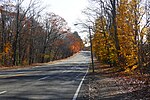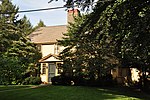Hammond Pond Reservation

Hammond Pond Reservation is a protected woodland park in Newton, Massachusetts. It features Hammond Pond, fishing and hiking trails as well as formations of sandstone conglomerate and Roxbury puddingstone which are popular for rock climbing.The reservation is part of the Metropolitan Park System of Greater Boston. Its first parcel was acquired from John Lowell in 1916. Trails connect it to the adjacent Webster Woods and Houghton Garden. The MBTA Green Line (Riverside Branch) cuts through the connected park system from East to West, while Hammond Pond Parkway splits it from North to South. Hammond Pond is listed as a Massachusetts "Great pond". The pond and reservation are named after the Hammond family, which settled in the area in the 17th century.
Excerpt from the Wikipedia article Hammond Pond Reservation (License: CC BY-SA 3.0, Authors, Images).Hammond Pond Reservation
Hammond Pond Parkway, Newton Thompsonville
Geographical coordinates (GPS) Address Nearby Places Show on map
Geographical coordinates (GPS)
| Latitude | Longitude |
|---|---|
| N 42.325 ° | E -71.176666666667 ° |
Address
Boston College
Hammond Pond Parkway 300
02159 Newton, Thompsonville
Massachusetts, United States
Open on Google Maps










